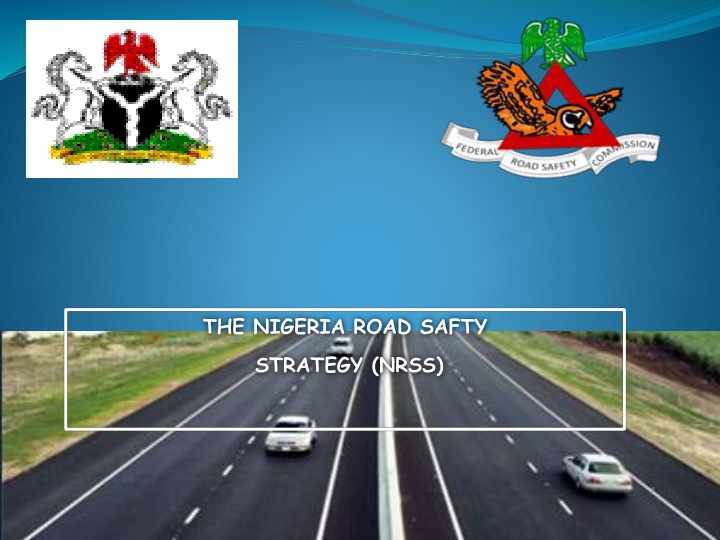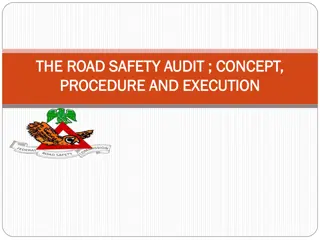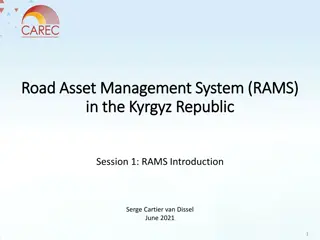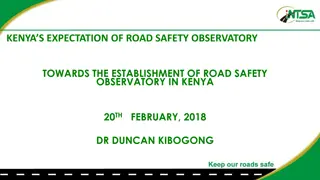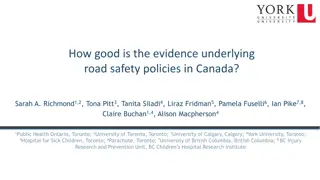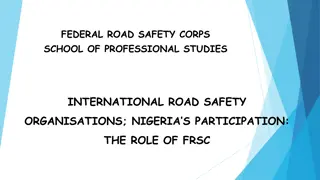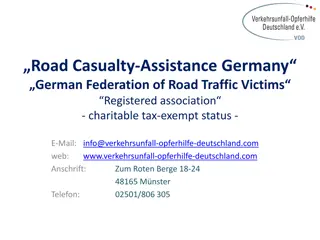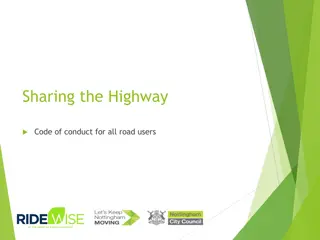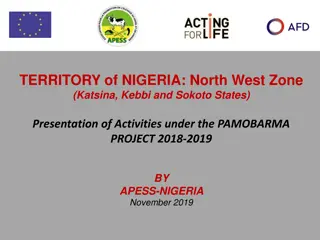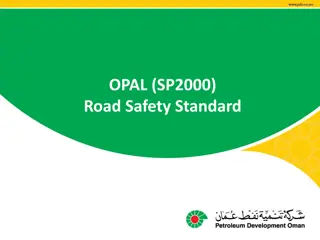Enhancing Road Safety in Nigeria: The NRSS Strategy
Nigeria Road Safety Strategy (NRSS) aims to address the high rate of Road Traffic Crashes (RTCs) in Nigeria through a collective effort to reduce fatalities and injuries. The document outlines the vision of achieving zero deaths from RTCs and a 35% reduction in fatality rate by 2020. NRSS emphasizes the importance of safe road usage for citizens' well-being and national development.
Download Presentation

Please find below an Image/Link to download the presentation.
The content on the website is provided AS IS for your information and personal use only. It may not be sold, licensed, or shared on other websites without obtaining consent from the author.If you encounter any issues during the download, it is possible that the publisher has removed the file from their server.
You are allowed to download the files provided on this website for personal or commercial use, subject to the condition that they are used lawfully. All files are the property of their respective owners.
The content on the website is provided AS IS for your information and personal use only. It may not be sold, licensed, or shared on other websites without obtaining consent from the author.
E N D
Presentation Transcript
THE NIGERIA ROAD SAFTY STRATEGY (NRSS)
Nigeria continues to feature in the bottom of country ranking as a result of the frequency of Road Traffic Crashes (RTCs) which have resulted in deaths and injuries without good or concerted effort towards addressing the problem. This trend deteriorated further especially in the right of United Nations (2011) projection that Nigeria population will grow to 200 million by 2020. Nigeria deplorable road traffic crash reality ranking of 176th position in 2010 also calls for a definite response to the hazards associated with road transportation in a country that is largely dependent on its road network for economic, social and physical activities. The WHO report (2018) revealed that the World RTC fatality is 1.35million per annum and RTC death is now the highest killer in the world today. Based on the above, there is a quest for best communication technique that will enhance compliance to road traffic rules and regulations thereby reducing RTC fatalities to Zero level.
AIM The aim of this paper is to clearly explain the concept of NRSS.
At the end of this paper presentation course participants should be able to: Define NRSS Understand the purpose and scope of the document. Be acquainted with current approach to road safety management. Know the NRSS frame work.
DEFINITION OF THE TERM NRSS NRSS (NIGERIA ROAD SAFETY STRATEGY): This is a concept, a document or proposal that covers the growing National consciousness on issues of road safety, this spirit of collective responsibility and determination to reduce the level of road traffic crashes (RTC s) and ensure that neither deaths nor serious injuries result from these crashes. The NRSS has the vision of a country where Road traffic crash result in no death and a goal of reducing road traffic crash fatality rate by 35% in 2020.
It is an important noble and timely intervention which supports entrenching the culture of safe use of Nigerian highways, the impact of which includes better quality of life for Citizens and the socio- economic growth of the Nation as a whole. This is also consistent with our national aspiration of repositioning the Country to be among the League of Nations with the best state of the roads in the World, in line with Federal Government change agenda. The NRSS (2016-2020) is the end product from all inclusive process with stakeholders drawn from both Public and Private Sectors of the economy.
The Strategy Document makes a detailed exposition of all distressing issues that have contributed to the present high rate of road carnage with about 4,000 lives and properties valued at close to two Trillion Naira lost in 2012 alone. The initiative is raising a national call for a wide adoption of Safe System Approach (SSA) to road safety management in Nigeria with the widest distribution of responsibilities ever witnessed in road safety management in Nigeria. The Safe System Approach is principled on four element of Human factor, Human frailty, forgiving system and share responsibilities.
The beauty of the new arrangement is that States and Local Governments will take and implement their own responsibilities under NRSS, making road safety management a national task. Key responsibilities are spelt out and road safety target set annually, and States will key in towards a new level of collaboration with FRSC. The NRSS highlights the current road safety situation in the country; intervention strategies; road safety management monitoring and evaluation framework; implementation cost and key success factors that makes for effective implementation of the Strategy.
The Document has already identified gaps in road safety management issues in Nigeria and has developed strategic initiatives to address them. The initiatives includes introduction of standard templates to capture and report relevant traffic data, legislate the establishment Administration Agencies in States and implement design standards for all road types. Others are to conduct road safety audit, safety impact assessment development, implementation awareness campaign on proper road use; and provide additional medical equipment and emergency rescue ambulances among others. To ensure that the NRSS document achieves its aim, the following strategies were adopted: of Motor Vehicle
Establishment of central database of road traffic data Review and upgrade road standards Promotion of construction, maintenance of road and the road network to meet mobility and access needed for all users according to the World best practices. Capacity building for comprehensive inspection of all imported vehicles according to the World best practices. Awareness campaign on proper road use and improved responsiveness to post crash emergencies. Identification identified strategic activities. and deployment of funds to
The development of Nigeria RoadSafety Strategy is in response to the UN Decade of action declaration for road safety (2011-2020), which demands that member Countries should develop a strategy to provide a direction towards achieving the vision for Safety, using the Safe System Approach. It was also necessitated by the Country Capacity Review (CCR) conducted by the World Bank in 2010 to measure Nigeria capacity to deliver on road safety. The Advisory council (Narsac) of the NRSS is to oversee the implementation of the NRSS. The council is headed by the Vice President of the Federal Republic of Nigeria as its Chairman; this council is to ensure co-ordination between Federal, States and Local Governments in achieving road safety transport World best practices in Nigeria.
PURPOSE OF THE DOCUMENT The NRSS seeks to Show or depict the current road safety To express through and feelings ready about the desired road safety saturation. To harmonize the different road safety effort by clearly expressing the vision, goal, purpose, output, target, as well as, the initiative for road safety in Nigeria; and develop a five year plan of action towards the achievement of established target.
Scope of the Document The NRSS provides an over view of current road safety management saturation, communicates desired road safety management saturation, propose a frame work for sustaining road safety management, highlight received intervention strategies recommendation of next steps towards successful implementation of this strategy and conclude with a
CURRENT APPROACH TO ROAD SAFETY MANAGEMENT Most recent attempts at managing road safety are covered in the Safe System Approach highlight in the ACCRA declaration of 2017 and the previous UN Decades of action recommendation of 2010. The Safe System Approach to road safety management begins with the acceptance of the superiority of human life and realization that road traffic crashes cannot be completely avoided although most are preventable. It regards road users as the walker s link in the transport chain, unpredictable, in spite of his level of education and access to information.
The approach therefore transport a major part of responsibility to road user and those who design the road transport system but does not encourage road users abduction of own duty. The goal of the safe system is to ensure that when crashes occur they do not result in serious human injury or death. This is sought to be achieved by focusing on keeping the impact energies that can produce either death or serious injuries below the threshold.
FEATURES OF SAFE SYSTEM APPROACH Recognition that preventive efforts notwithstanding road users will remain fallible, and shared responsibility among persons responsible for the design of road transport system (to make it safe) and users of the system (with obligation to comply with the rules and constraints of the system). Alignment of safety management decisions with broader transport and planning decisions covering wider economic, human and environmental goals. Shaping interventions to achieve a long term goal, rather than relying on traditional models to get the limits of any long term target.
FEATURES OF SAFE SYSTEM APPROACH cont Consists of five main corner stone s safe vehicle, safe infrastructure (road and mobility). Safe road user behavior, improved road safety management (systems) and post crash response and care.
THE NRSS FRAMEWORK To sustain the Nigeria Road Safety Strategy process and move the country closer to achieving its road safety vision Road Traffic Crash resulting in no death . The NRSS has been developed and will be managed through a set of framework that will ensure accountability, transparency and focus on road safety. Strategic Management: it involves blue print to guide road safety management based on the Safe Systems Approach It is organized into a hierarchy of vision, goal, purpose, output and strategic activities. Activity Management: activities required to achieve the goal and deliver the outputs as established by the National Road Safety Advisory Council (NARSAC).
THE NRSS FRAMEWORK cont. Outcome Assessment: Guidance for the assessment, projection and measurement of benefits of implemented strategies. Performance management: set of clear performance indication (PIs) to monitor progress. These may be adjusted as may be required and has clearly spelt out accountabilities.
THE IMPORTANCE OF NRSS TO THE NATION Global Imperative Economic Imperative Transformation Imperative Behavioral Imperative Socio-Political Imperative National Image Imperative
The Nigeria Road Safety Strategy (NRSS) is adopted in pursuant to a road traffic crash free society in which road traffic crashes result in neither death nor serious injuries as it is in developed Nations of the World. One common fruit among these countries with comparatively better fatality index is a documented road safety strategy. It is expected that in no time the World Health Organization estimate of 33.7 deaths per hundred thousand populations in Nigeria is addressed by this document.
Having known the scourge of road challenges in Nigeria, it is envisage that the NRSS will become actionable upon conclusion of the following key steps. Stake holders sensitization and public enlightenment Develop and approve legal frame work Devise and obtain funding Develop budget and implement strategic activities
